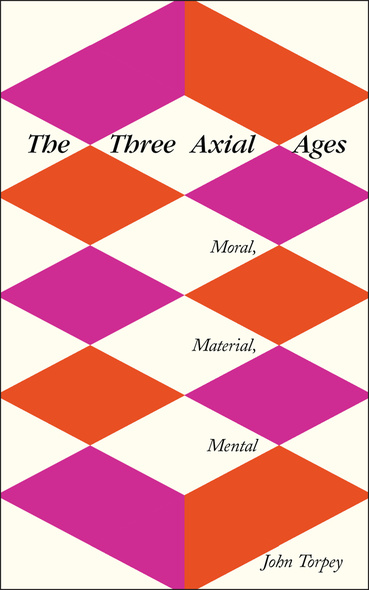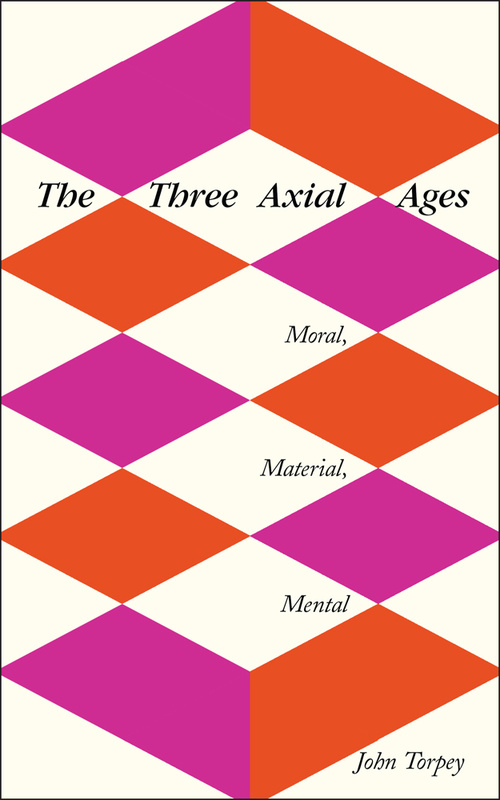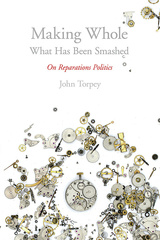
118 pages, 5 x 8
Paperback
Release Date:01 Mar 2017
ISBN:9780813590509
Hardcover
Release Date:01 Mar 2017
ISBN:9780813590516
How should we think about the “shape” of human history since the birth of cities, and where are we headed? Sociologist and historian John Torpey proposes that the “Axial Age” of the first millennium BCE, when some of the world’s major religious and intellectual developments first emerged, was only one of three such decisive periods that can be used to directly affect present social problems, from economic inequality to ecological destruction.
Torpey’s argument advances the idea that there are in fact three “Axial Ages,” instead of one original Axial Age and several subsequent, smaller developments. Each of the three ages contributed decisively to how humanity lives, and the difficulties it faces. The earliest, or original, Axial Age was a moral one; the second was material, and revolved around the creation and use of physical objects; and the third is chiefly mental, and focused on the technological. While there are profound risks and challenges, Torpey shows how a worldview that combines the strengths of all three ages has the potential to usher in a period of exceptional human freedom and possibility.
Torpey’s argument advances the idea that there are in fact three “Axial Ages,” instead of one original Axial Age and several subsequent, smaller developments. Each of the three ages contributed decisively to how humanity lives, and the difficulties it faces. The earliest, or original, Axial Age was a moral one; the second was material, and revolved around the creation and use of physical objects; and the third is chiefly mental, and focused on the technological. While there are profound risks and challenges, Torpey shows how a worldview that combines the strengths of all three ages has the potential to usher in a period of exceptional human freedom and possibility.
As usual, John Torpey's new book is concisely written, and filled with interesting bits of information and lucid observations … I'm sure it will attract interest and favorable attention.
The boldness and contemporary relevance of arguments like these are what make this small book an enjoyable and 'teachable' tool for sociologists and historians.
For those wondering how recent work on economic and social history bears on the received wisdom of historical sociology, Torpey weaves together a compelling new narrative. [The book] seeks a balance between the pessimistic vision of human history that typically prevails within sociology and the more optimistic view that is characteristic of economics. Torpey does not downplay the perils of the present moment, but he is also attuned to its promise.
Interview with John Torpey on New Books Network
JOHN TORPEY is a professor of sociology and history at the Graduate Center, City University of New York, and director of the Ralph Bunche Institute for International Studies at the Graduate Center. He is the author or coauthor of eight books, including Legal Integration of Islam: A Transatlantic Comparison.
From the preface
This brief book arose from a certain disquiet about a recent discussion among (mainly) sociologists regarding the historical significance of the so-called Axial Age, the period in the middle centuries of the first millennium BCE when some of the world’s major religions and intellectual developments emerged in China, India, the Middle East, and ancient Greece. The human significance of the birth of some of the world’s most influential intellectual traditions was surely a matter that should command our attention and interest. This was especially true for me, given that one of the principal contributors to the discussion was a mentor of mine, the distinguished sociologist of religion Robert Bellah. Bob had always been an eclectic thinker, but also a profound one. His magnum opus on the Axial Age (Religion in Human Evolution) is astonishing in its range and depth of knowledge about the world’s religious traditions. It also reads like an elaboration on Durkheim and Weber as guides to understanding the role of religion in human life. The book also had roots in a famous article of his from more than fifty years earlier, “Religious Evolution,” whose stage-wise characterization of human religious development Bob attributed to his “early involvement with Marxism.”1 Religion in Human Evolution thus appeared in certain respects like a textbook based on sociology’s “holy trinity” and reflecting their divergent ways of thinking about social life.
Yet there is no denying that the book, and the discussion of the Axial Age more generally, is profoundly idealist in its preoccupations. The defenders of the Axial Age thesis—that “man as we know him today” came into existence during that remarkable period two and a half millennia ago—take the position that the different intellectual traditions that arose at that time provide the basic modes of thinking of a large proportion of the world’s peoples today. In view of the fact that we are talking about Buddhism, Hinduism, Confucianism, Taoism, Greek philosophy, and Judaism and its “Abrahamic” descendants, there is of course much to be said for this view; indeed, the “world religions” are so designated precisely because they shape the worldviews of substantial populations around the world. In part inspired by Michael Mann’s writings, however, I believe we need to pay attention not just to the ideas but to various dimensions of particular epochs as well if we are to make sense of which factors predominate in defining particular historical conjunctures. Hence the three Axial Ages that I delineate in the pages that follow revolve principally, though of course by no means exclusively, around different historical “axes”: the moral, the material, and the mental, respectively. What I mean by each of these terms will, I hope, become clear in the course of the exposition.
The present work also feeds off another sort of disquiet: that regarding the missing normative dimension of contemporary sociology. Having originally been an attempt to make sense of the modern world as it emerged from its predecessor agricultural societies, sociology has largely been reduced to the study of inequality, and is essentially “deconstructive” in character. That is, it is generally critical of current social arrangements of many kinds, but it shrinks from presenting more desirable social arrangements of its own. This non-normative stance contrasts notably with that of contemporary political science. The point can be made by comparing the place of “theory” in each field. Political theory, if hardly likely to vault a young scholar to the commanding heights of the discipline, is a perfectly legitimate—indeed, a venerable—part of the field, with a firm footing in the departments at leading universities. More importantly, political theory remains preoccupied with the nature and meaning of “the good life,” as it has been ever since Plato and Aristotle. By contrast, in what is undoubtedly a negative legacy of Weber’s strict Kantian distinction between the “is” and the “ought,” “social theory” is about understanding society better, not about making society better. Hence the work of a normatively oriented scholar such as Jürgen Habermas, surely the most influential German social thinker of the second half of the twentieth century and often described as a sociologist, has little relevance to contemporary (American) sociology—especially by comparison with Pierre Bourdieu, an incisive thinker about matters of inequality but not a political or moral thinker of great import. The discussion about the Axial Age has thus been important because it has been a way to return moral considerations to the heart of sociological thinking. In that sense, it is not surprising that Robert Bellah, the coauthor of Habits of the Heart and the companion volume The Good Society, was deeply drawn to this discussion. The fact is that it was Bellah’s teacher, Talcott Parsons, who stimulated attention among his students to the Axial Age after his own encounters with German philosophers and sociologists in the period before the Nazi seizure of power. Parsons’s conception of sociology was notably idealist in character, however, and this set of emphases carried over to his students.
In what follows, I argue that, rather than only one Axial Age, there have in fact been three “Axial Ages,” each with
a distinctive character, which have decisively shaped human life since the birth of agriculture some ten thousand years ago. The “original” Axial Age was “moral” in orientation; the second, beginning around 1750, was “material” in character; and the third, contemporary Axial Age is chiefly “mental” in nature. The point of these designations is obviously not to suggest that they are the exclusive focus of human attention in these different periods, but rather that they set the dominant tone for each of those periods. It took more than two thousand years for the “material” Axial Age to follow the first, moral Axial Age. It did so because a particular concatenation of events having little (but not nothing) to do with the moral developments of the first Axial Age led to a breakthrough in human productivity unprecedented in human history (and largely inconceivable throughout most of that history). The idea of progress thus became a major preoccupation of writers such as Condorcet, because for the first time in human history it became a serious possibility.2 The current mental Axial Age is, in turn, an outgrowth of the previous two, and it continues the efficiency orientation of the second Axial Age on an infinitesimal (atomic, molecular, or perhaps “nano”) scale.
Our era will have to activate the moral and intellectual sensibilities cultivated in the first Axial Age if the human species is going to survive the costs generated by the extraordinary productivity gains of the second Axial Age. That is, the best traditions of modern science will have to combine with the most universalistic features of the Axial Age religions to pull the inhabitants of the planet back from the brink of self-destruction. There is every reason to think that intelligence and empathy can save us from the worst, so long as we use the tools we have been given by the Axial Age traditions to take seriously the challenges that confront us.
This brief book arose from a certain disquiet about a recent discussion among (mainly) sociologists regarding the historical significance of the so-called Axial Age, the period in the middle centuries of the first millennium BCE when some of the world’s major religions and intellectual developments emerged in China, India, the Middle East, and ancient Greece. The human significance of the birth of some of the world’s most influential intellectual traditions was surely a matter that should command our attention and interest. This was especially true for me, given that one of the principal contributors to the discussion was a mentor of mine, the distinguished sociologist of religion Robert Bellah. Bob had always been an eclectic thinker, but also a profound one. His magnum opus on the Axial Age (Religion in Human Evolution) is astonishing in its range and depth of knowledge about the world’s religious traditions. It also reads like an elaboration on Durkheim and Weber as guides to understanding the role of religion in human life. The book also had roots in a famous article of his from more than fifty years earlier, “Religious Evolution,” whose stage-wise characterization of human religious development Bob attributed to his “early involvement with Marxism.”1 Religion in Human Evolution thus appeared in certain respects like a textbook based on sociology’s “holy trinity” and reflecting their divergent ways of thinking about social life.
Yet there is no denying that the book, and the discussion of the Axial Age more generally, is profoundly idealist in its preoccupations. The defenders of the Axial Age thesis—that “man as we know him today” came into existence during that remarkable period two and a half millennia ago—take the position that the different intellectual traditions that arose at that time provide the basic modes of thinking of a large proportion of the world’s peoples today. In view of the fact that we are talking about Buddhism, Hinduism, Confucianism, Taoism, Greek philosophy, and Judaism and its “Abrahamic” descendants, there is of course much to be said for this view; indeed, the “world religions” are so designated precisely because they shape the worldviews of substantial populations around the world. In part inspired by Michael Mann’s writings, however, I believe we need to pay attention not just to the ideas but to various dimensions of particular epochs as well if we are to make sense of which factors predominate in defining particular historical conjunctures. Hence the three Axial Ages that I delineate in the pages that follow revolve principally, though of course by no means exclusively, around different historical “axes”: the moral, the material, and the mental, respectively. What I mean by each of these terms will, I hope, become clear in the course of the exposition.
The present work also feeds off another sort of disquiet: that regarding the missing normative dimension of contemporary sociology. Having originally been an attempt to make sense of the modern world as it emerged from its predecessor agricultural societies, sociology has largely been reduced to the study of inequality, and is essentially “deconstructive” in character. That is, it is generally critical of current social arrangements of many kinds, but it shrinks from presenting more desirable social arrangements of its own. This non-normative stance contrasts notably with that of contemporary political science. The point can be made by comparing the place of “theory” in each field. Political theory, if hardly likely to vault a young scholar to the commanding heights of the discipline, is a perfectly legitimate—indeed, a venerable—part of the field, with a firm footing in the departments at leading universities. More importantly, political theory remains preoccupied with the nature and meaning of “the good life,” as it has been ever since Plato and Aristotle. By contrast, in what is undoubtedly a negative legacy of Weber’s strict Kantian distinction between the “is” and the “ought,” “social theory” is about understanding society better, not about making society better. Hence the work of a normatively oriented scholar such as Jürgen Habermas, surely the most influential German social thinker of the second half of the twentieth century and often described as a sociologist, has little relevance to contemporary (American) sociology—especially by comparison with Pierre Bourdieu, an incisive thinker about matters of inequality but not a political or moral thinker of great import. The discussion about the Axial Age has thus been important because it has been a way to return moral considerations to the heart of sociological thinking. In that sense, it is not surprising that Robert Bellah, the coauthor of Habits of the Heart and the companion volume The Good Society, was deeply drawn to this discussion. The fact is that it was Bellah’s teacher, Talcott Parsons, who stimulated attention among his students to the Axial Age after his own encounters with German philosophers and sociologists in the period before the Nazi seizure of power. Parsons’s conception of sociology was notably idealist in character, however, and this set of emphases carried over to his students.
In what follows, I argue that, rather than only one Axial Age, there have in fact been three “Axial Ages,” each with
a distinctive character, which have decisively shaped human life since the birth of agriculture some ten thousand years ago. The “original” Axial Age was “moral” in orientation; the second, beginning around 1750, was “material” in character; and the third, contemporary Axial Age is chiefly “mental” in nature. The point of these designations is obviously not to suggest that they are the exclusive focus of human attention in these different periods, but rather that they set the dominant tone for each of those periods. It took more than two thousand years for the “material” Axial Age to follow the first, moral Axial Age. It did so because a particular concatenation of events having little (but not nothing) to do with the moral developments of the first Axial Age led to a breakthrough in human productivity unprecedented in human history (and largely inconceivable throughout most of that history). The idea of progress thus became a major preoccupation of writers such as Condorcet, because for the first time in human history it became a serious possibility.2 The current mental Axial Age is, in turn, an outgrowth of the previous two, and it continues the efficiency orientation of the second Axial Age on an infinitesimal (atomic, molecular, or perhaps “nano”) scale.
Our era will have to activate the moral and intellectual sensibilities cultivated in the first Axial Age if the human species is going to survive the costs generated by the extraordinary productivity gains of the second Axial Age. That is, the best traditions of modern science will have to combine with the most universalistic features of the Axial Age religions to pull the inhabitants of the planet back from the brink of self-destruction. There is every reason to think that intelligence and empathy can save us from the worst, so long as we use the tools we have been given by the Axial Age traditions to take seriously the challenges that confront us.
Preface vii
Introduction 1
1. The Moral Axial Age 7
2. The Material Axial Age 33
3. The Mental Axial Age 50
Notes 79
Index 97
Introduction 1
1. The Moral Axial Age 7
2. The Material Axial Age 33
3. The Mental Axial Age 50
Notes 79
Index 97





